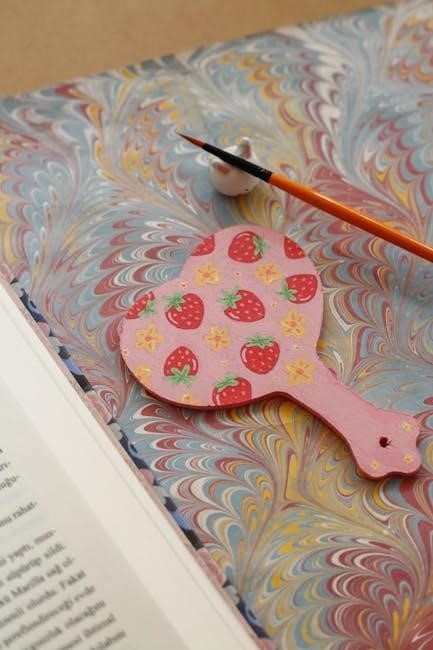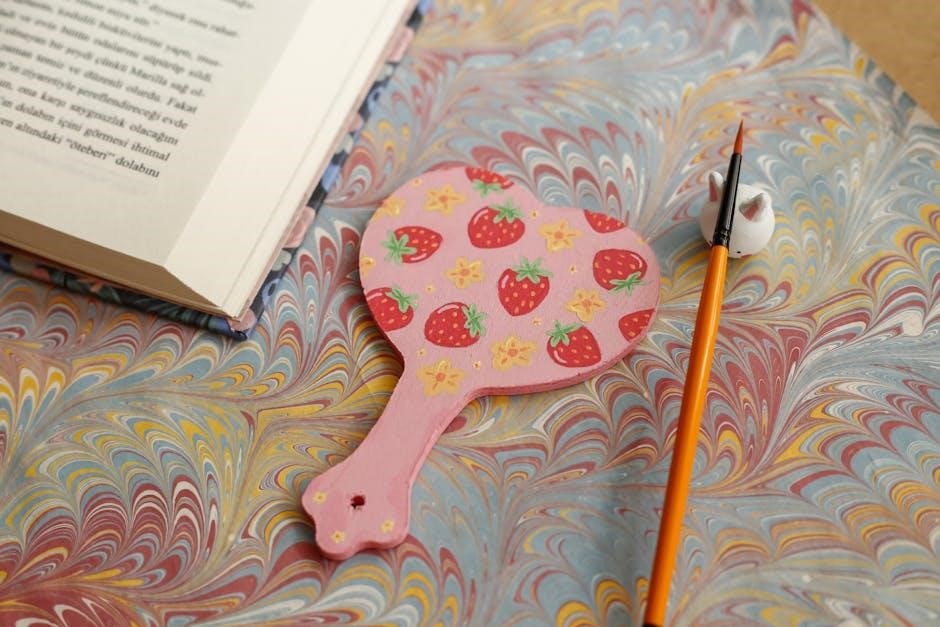A design sprint is a structured, time-boxed process for solving complex problems through collaborative ideation, prototyping, and testing. Popularized by Jake Knapp’s book Sprint, it enables teams to rapidly validate ideas, reduce risks, and achieve alignment. This innovative approach has become essential for modern problem-solving, offering a clear path from concept to actionable solutions in just five days.
1.1 What is a Design Sprint?

A Design Sprint is a structured, five-day process for solving complex problems through collaborative ideation, prototyping, and testing. Originating from Google Ventures and popularized by Jake Knapp’s book Sprint, it accelerates innovation by condensing months of work into a single week. Teams align on a clear goal, sketch solutions, decide on the best ideas, build prototypes, and test them with real users. This iterative approach reduces risks and provides actionable insights, ensuring teams deliver high-impact solutions efficiently. Available as an online PDF, the book serves as a step-by-step guide for conducting successful sprints.
1.2 The Origin of Design Sprint
The Design Sprint concept was developed by Jake Knapp during his time at Google Ventures. Knapp, a renowned designer and author, refined the process to help teams solve complex problems efficiently. His book, Sprint, published in 2016, introduced the five-day structured approach to the world. The method combines brainstorming, prototyping, and user testing, drawing from Knapp’s experiences at Google, Microsoft, and other tech giants. Available as an online PDF, the book has become a cornerstone for modern design thinking, offering a step-by-step guide to conducting successful sprints and driving innovation.
1.3 Importance of Design Sprint in Modern Problem-Solving
The Design Sprint has become a cornerstone of modern problem-solving due to its ability to deliver actionable solutions quickly. In today’s fast-paced environment, businesses need efficient methods to validate ideas before full-scale implementation. The sprint process reduces risks by testing prototypes with real users, ensuring resources are invested wisely. Its collaborative nature fosters team alignment and creativity, making it a vital tool for startups and corporations alike. As detailed in Jake Knapp’s Sprint, available as an online PDF, this approach has revolutionized how teams tackle challenges, providing a clear path from concept to execution in just five days.

Benefits of a Design Sprint
A Design Sprint accelerates problem-solving, aligns teams, and reduces risks by validating ideas through rapid prototyping and user testing, ensuring efficient and informed decision-making.
2.1 Time Efficiency in Solving Complex Problems
A Design Sprint condenses months of deliberation into five focused days, ensuring rapid progress. By prioritizing tasks and minimizing distractions, teams efficiently tackle complex challenges, delivering actionable solutions swiftly. This structured approach eliminates prolonged debates, allowing for quick iteration and refinement. Time efficiency is maximized through predefined stages, ensuring each day builds on the previous, leading to a tested prototype by the end of the week. This method is particularly valuable for teams facing tight deadlines or uncertain outcomes.
2.2 Enhanced Collaboration and Team Alignment

A Design Sprint fosters enhanced collaboration by bringing cross-functional teams together to share perspectives and align on goals. The structured process ensures everyone contributes equally, reducing miscommunication and fostering a shared understanding. By working in a time-boxed environment, teams stay focused and motivated, leading to stronger alignment and collective ownership of solutions. This collaborative approach not only strengthens team dynamics but also ensures that all voices are heard, resulting in more holistic and innovative outcomes.
2.3 Risk Reduction Through Prototyping and Testing
Prototyping and testing are core components of a Design Sprint, enabling teams to validate ideas before full implementation. By creating tangible prototypes, teams can gather real user feedback, identify potential flaws, and refine solutions early in the process. This approach significantly reduces the risk of investing time and resources into concepts that may not resonate with users. Testing prototypes also provides actionable insights, allowing teams to make data-driven decisions and iterate effectively. This iterative process ensures that the final solution is both user-centric and aligned with business goals, minimizing overall risk and enhancing success rates.

The Design Sprint Process
The Design Sprint Process is a five-day collaborative problem-solving approach, transforming challenges into actionable solutions through structured ideation, prototyping, and testing, yielding a validated prototype.
3.1 Day 1: Understanding the Problem and Setting Goals
Day 1 focuses on deeply understanding the problem and defining clear goals. The team maps out the challenge, identifies key stakeholders, and aligns on objectives. Through open discussions and expert interviews, participants gain a shared understanding of the problem’s complexities. The day concludes with setting a clear, ambitious goal for the sprint. This foundation ensures everyone is on the same page, ready to explore solutions in the days ahead. The structured approach accelerates progress, ensuring the team is committed to a unified vision for the next five days.
3.2 Day 2: Sketching and Ideation
Day 2 is dedicated to individual sketching and ideation. Each team member privately sketches potential solutions, exploring a wide range of ideas without judgment. The goal is to generate diverse concepts, ensuring no idea is dismissed early. After sketching, the team reviews and builds on each other’s work, creating a collaborative and creative environment. This phase encourages wild, ambitious ideas while maintaining focus on the problem defined on Day 1. By the end of Day 2, the team has a collection of innovative solutions to refine and narrow down in the next steps.
3.3 Day 3: Deciding on the Best Solution
Day 3 focuses on critiquing and selecting the most promising ideas from Day 2. The team reviews all sketches, discusses their merits, and votes on the top concepts. This collaborative critique ensures alignment and narrows down the options to the strongest solutions. By the end of the day, the team agrees on a single direction or a few top ideas to move forward with. This decision sets the stage for prototyping on Day 4, ensuring everyone is aligned and focused on the best potential solutions.
3.4 Day 4: Prototyping
Day 4 is dedicated to transforming the chosen idea into a functional prototype. The team collaborates to build a realistic, testable version of the solution, focusing on key features and user interactions. Designers craft high-fidelity visuals, while others handle coding or content creation. The goal is to create a prototype that closely resembles the final product, allowing for authentic user feedback on Day 5. This hands-on approach ensures the concept is tangible and ready for real-world testing, providing a clear direction for refinement and iteration.
3.5 Day 5: Testing and Feedback
Day 5 focuses on testing the prototype with real users to gather actionable feedback. The team observes how users interact with the solution, identifying strengths and areas for improvement. This step is crucial for validating assumptions and refining the concept. Feedback is collected through structured interviews or surveys, providing insights that guide further iterations. By the end of this day, the team has a clear understanding of what works and what doesn’t, enabling informed decisions for the next steps in the project.

Tools and Materials Needed for a Design Sprint
A design sprint requires essential tools and materials to facilitate collaboration and creativity. Digital tools like Miro and Figma aid in prototyping, while physical materials such as sticky notes, whiteboards, and craft supplies support brainstorming and ideation.
4.1 Digital Tools for Collaboration and Design
Digital tools are essential for facilitating collaboration and design during a design sprint. Platforms like Miro and Figma enable teams to brainstorm, sketch, and prototype ideas in real-time. These tools offer features such as digital whiteboards, collaborative editing, and version control, making it easier to iterate and refine concepts. Additionally, Google Workspace and Slack support communication and document sharing, ensuring seamless teamwork. These tools not only enhance productivity but also allow for remote participation, making design sprints accessible to global teams. They are integral to the success of modern design sprint processes.
4.2 Physical Materials for Brainstorming and Prototyping
Physical materials play a vital role in design sprints, fostering creativity and hands-on collaboration. Sticky notes, whiteboards, and markers are essential for brainstorming and visualizing ideas. Sketch paper and pens allow participants to quickly draft concepts, while prototyping materials like cardboard, foam, and craft supplies help create tangible, testable models. These tools enable teams to iterate rapidly and explore ideas in a tactile way, making abstract concepts more concrete and actionable during the sprint process.
Case Studies of Successful Design Sprints
Explore real-world successes, such as Google Ventures’ approach, showcasing how design sprints solve complex problems and test ideas efficiently, as detailed in Jake Knapp’s book.
5.1 Google Ventures and Their Approach to Design Sprints
Google Ventures pioneered the design sprint methodology, leveraging it to solve complex challenges swiftly. As detailed in Jake Knapp’s book, their structured process involves understanding the problem, ideation, prototyping, and testing within five days. This approach reduces risks and accelerates innovation, ensuring alignment among teams. Google Ventures has successfully applied design sprints to enhance user experiences, launch new features, and validate ideas, demonstrating its effectiveness in real-world scenarios. Their method serves as a blueprint for organizations seeking to adopt this transformative problem-solving approach.

5.2 Real-World Applications of Design Sprints
Design sprints have been widely adopted across industries to tackle real-world challenges. Companies like Google, Airbnb, and Uber have used this methodology to innovate rapidly. For instance, healthcare organizations have applied design sprints to improve patient care solutions, while financial institutions have leveraged them to enhance user experiences. Education platforms have also benefited by refining their digital offerings. These applications demonstrate how design sprints can drive tangible results, from reducing costs to increasing customer satisfaction. The versatility of this approach makes it a powerful tool for addressing diverse business and societal needs effectively.
How to Facilitate a Design Sprint
Facilitating a design sprint requires clear leadership, structured agendas, and active participation. Assign roles, manage time effectively, and encourage open collaboration to ensure successful outcomes.
6.1 Roles and Responsibilities in a Design Sprint
In a design sprint, clear roles ensure efficiency. The Facilitator guides the process, while the Decider makes final decisions. Designers sketch solutions, Marketers provide customer insights, and Engineers assess technical feasibility. Experts offer domain knowledge. Each role contributes uniquely, fostering collaboration and accountability. This structured approach ensures diverse perspectives are heard, leading to well-rounded solutions. By defining responsibilities upfront, teams avoid confusion and stay focused on the sprint’s goals.
6.2 Tips for Effective Facilitation
Effective facilitation in a design sprint requires creating a safe, collaborative environment. Encourage wild ideas and ensure everyone’s voice is heard. Use time-boxed activities to maintain momentum and focus. Guide the group without imposing your own opinions, fostering a culture of constructive feedback. Stay organized, keep the process transparent, and remind the team of the sprint’s goals. By balancing structure and creativity, you enable the team to thrive and produce innovative solutions. Refer to resources like Jake Knapp’s Sprint for additional insights on mastering facilitation techniques.
Common Challenges and Solutions
Common challenges include creative blocks and time constraints. Solutions involve structured brainstorming, time-boxed activities, and iterative prototyping to maintain focus and drive innovation effectively.
7.1 Overcoming Creative Blocks

Creative blocks are common in design sprints, but strategies like time-boxed brainstorming and mind mapping can help. Encourage wild ideas to stimulate creativity and reduce fear of failure. Structured activities, such as silent sketching, ensure all voices are heard. Lateral thinking exercises also foster innovation. Breaks and refocusing techniques can reignite momentum. Emphasize progress over perfection to keep the team motivated. These methods ensure creative flow and maintain the sprint’s momentum, leading to breakthrough solutions.

7.2 Managing Time Constraints
Effective time management is crucial in design sprints, as the process is strictly time-boxed. Teams must prioritize tasks, focusing on high-impact activities. Time-boxed exercises ensure progress without overcomplicating ideas. Regular check-ins and clear deadlines help maintain momentum. Tools like timers and visual schedules enhance accountability. Encouraging decisive decision-making prevents delays. By staying focused on the sprint’s goals, teams can efficiently allocate time, ensuring all phases are completed within the five-day framework. Proper time management is key to unlocking the sprint’s full potential and delivering actionable results.
Resources for Learning More
Explore Jake Knapp’s Sprint for a step-by-step guide. Online courses and tutorials offer practical skills, while communities and forums provide ongoing support and shared experiences.
8.1 The Book “Sprint” by Jake Knapp
Jake Knapp’s Sprint is a comprehensive guide to design sprints, offering a step-by-step approach to solving big problems and testing ideas in just five days. The book, available as an eBook and a 1-Page PDF summary, provides practical tools and real-world examples. Knapp, a pioneer in the field, shares insights from his work at Google Ventures, making it an essential resource for teams aiming to innovate efficiently. Whether you’re new to design sprints or looking to refine your process, Sprint delivers actionable strategies and inspiration to accelerate your creative problem-solving journey.
8.2 Online Courses and Tutorials

Online courses and tutorials provide hands-on training in design sprints, offering step-by-step guides and expert instruction. Platforms like Udemy and Coursera feature courses that cover the entire sprint process, from problem definition to prototyping. Many courses include interactive exercises, case studies, and downloadable resources, such as templates and worksheets. These tutorials are ideal for individuals and teams looking to master design sprints without formal training. They also serve as a complement to Jake Knapp’s book, offering practical skills to apply the sprint methodology effectively in real-world scenarios.
8.3 Design Sprint Communities and Forums
Design sprint communities and forums offer valuable spaces for discussion, learning, and networking. These platforms connect professionals, allowing them to share experiences, ask questions, and gain insights. Many communities provide access to resources, such as downloadable templates and case studies. Forums also host discussions on best practices, common challenges, and success stories. Engaging with these groups can enhance your understanding of design sprints and help you stay updated on the latest trends. They serve as a complementary resource to books like Sprint, offering real-world applications and peer support.

Leave a Reply
You must be logged in to post a comment.